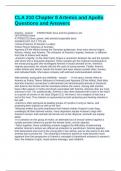CLA 210 Chapter 8 Artemis and Apollo
Questions and Answers
Artemis - answer PARENTAGE Zeus and the goddess Leto
OFFSPRING None
ATTRIBUTES Bow, quiver, wild animals (especially deer)
SIGNIFICANT CULT TITLES
Lochia (Protector of Women in Labor)
Potnia Theron (Mistress of Animals)
Agrotera (Of the Wilds)-Among the Olympian goddesses, three were eternal virgins:
Athena, Hestia, and Artemis. The character of Artemis's virginity, however, is different
from that of Athena and Hestia
-Artemis's virginity, on the other hand, forges a connection between her and the nymphs
with whom she is frequently depicted. These nymphs are the mythical counterparts to
the mortal young girls who worshipped Artemis in rituals devoted to her. Artemis's
virginity associates her closely with the life cycle of young women. Finally, Artemis,
unlike Athena and Hestia, haunts the forests and open spaces outside cities, houses,
and cultivated fields. She keeps company with wild and undomesticated animals.
Wild animals, young girls and childbirth - answer -In his epics, Homer refers to
Artemis as Potnia Theron (Mistress of Animals) and Agrotera (Of the Wilds). Both titles
describe Artemis's connection to wild animals (not domesticated animals or livestock)
who dwell in the forests and the mountains where she roams. Among wild animals,
bears often appear in myths and rituals associated with Artemis, whereas deer are most
precious to her. Yet, paradoxically, Artemis is also often depicted with a bow in her hand
or a quiver of arrows on her back (Figure 8.2). Her bow is not a weapon of war but a
tool of the hunt. Thus Artemis is represented as both protecting and hunting animals in
the wild.
-Artemis is often portrayed as leading groups of nymphs in song or dance, and
protecting their virginity as well as her own
-Whereas written accounts emphasize that Artemis makes Actaeon's own dogs
unwittingly kill their beloved master, many depictions equate Actaeon's dogs with
Artemis's arrows: both animals and arrows are at her disposal, and both are equally
lethal
-In a variation on this group of myths, an attempted act of sexual violence against a
nymph provokes Artemis to punish the female victim, not her attacker.
-Taken together, these conflicting versions suggest the difficulties of determining
whether Artemis's actions are offered as protection or punishment. Artemis appears
both benevolent and cruel to the young girls in her retinue, just as she seems to the wild
animals that surround her. The meaning of Artemis's actions in myth becomes more
apparent from the perspective of Artemis's oversight of transitional moments in women's
lives: the initiation of girls, rituals before marriage, and childbirth.
, -Artemis is called Lochia (Protector of Women in Labor), and her own birth illustrates
this feature of her character. Angry with Zeus for philandering, Hera would not let any la
Hippolytus in myth and ritual - answer -A myth concerning Hippolytus—one of
Artemis's adolescent male worshippers—and a ritual for brides that Artemis establishes
in his honor offers a way to understand how Artemis attends to her devotees. In his play
Hippolytus (c. 428 BCE), Euripides depicts Hippolytus as a young man, a virgin and a
hunter who prefers the woods and the company of other young men to the city and the
demands of adulthood. Hippolytus hoped to remain forever under the auspices of
Artemis and never mature into a married man and warrior.
-At the close of the play, Artemis promises Hippolytus that young women in his
hometown of Troezen will cut their hair and sing laments for him before they marry. (In
other versions of this myth, Artemis rescues Hippolytus and installs him as a king or as
a temple servant in Aricia, in Italy.)
-At first glance, this wedding ritual seems paradoxical because it requires young brides
to commemorate Hippolytus's virginal devotion to Artemis (and, perhaps, his rejection of
Aphrodite) and to mourn his death. Yet, if Hippolytus represents the youthful virginity
and devotion to Artemis that young girls must relinquish on marriage, then lamenting his
death could be seen as a way for girls to recognize and ritually mourn the end of their
own youth and virginity. Moreover, the violence and sorrow attached to Hippolytus's
death allows a young bride to address her conflicting emotions on her marriage: once
she is transferred from her father's household to her husband's, she forever leaves
behind her natal family.
-Hippolytus's myth and the Troezen ritual, then, connect mythic transformation and
death with the losses that adolescents experience when they must enter into a new
stage of their lives. Artemis oversees this moment that is both joyful and sorrowful;
thereby she herself appears both cruel and benevolent, and her ro
Girls' initiations: The Brauronia - answer -The most important initiation that Artemis
oversaw was at Brauron, a region due east of Athens on the Aegean coast. When girls
were initiated at Brauron, they were described as "playing the bear" for Artemis in a
ritual variously called the Brauronia, a title emphasizing the ritual's location, or the
Arcteia, a title that emphasizes the importance of bears in the worship of Artemis
-Afterward, the Athenians become ill until an oracle advises them that in order to be
cured they must make young girls "play the bear" for Artemis, who was angered over
the death of the she-bear.
-Archaeological evidence from the site at Brauron offers information about how girls
played the bear for Artemis. A building structure with small rooms for sleeping suggests
that girls stayed in Brauron, away from their families, during the festival. Small votive
statues and vase paintings of young girls found at Brauron indicate that the age range
of girls who played the bear was quite wide—perhaps from five to sixteen years, most
certainly before they married (estimated to take place after the age of twelve and ideally
between fourteen and sixteen years).
-Vases from Brauron also suggest what sorts of activities constituted playing the bear:
girls ran, danced, and even offered their toys to the goddess (Figure 8.4). These actions





